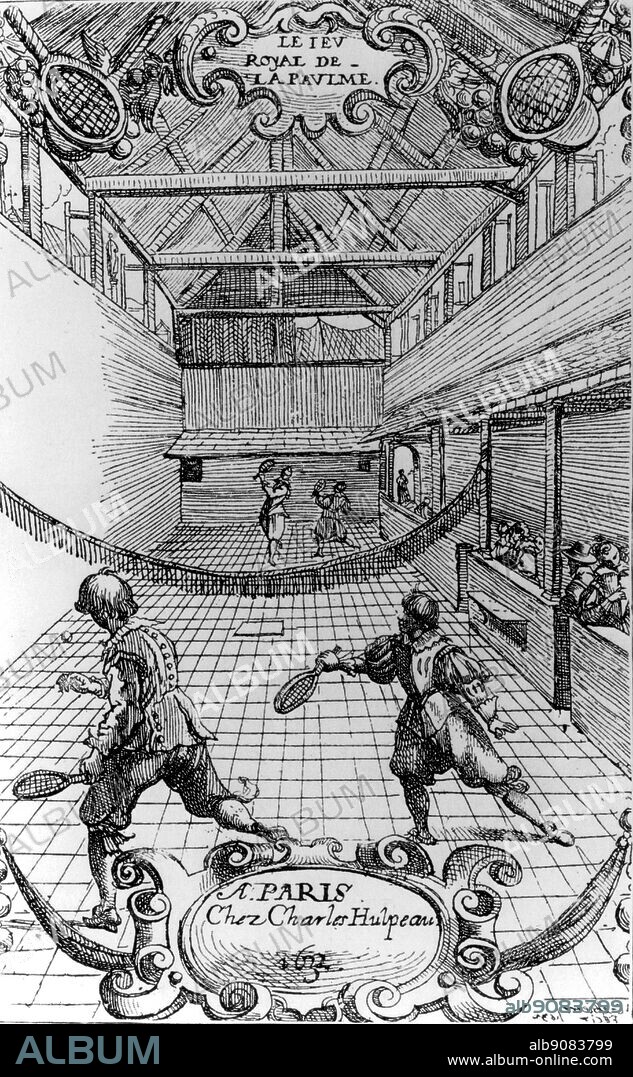alb9083799
Built under Louis XIV, the Jeu de Paume is an indoor tennis court insofar as the game played there was an ancestor of modern tennis. On June 20, 1789, this hall was the site of a major event in the French Revolution. Back in May of that year, Louis XVI convoked the three orders of the Estates General (Nobles, Clergy, and Commoners) to discuss needed reforms. They met in the large Hall of Revels (which today houses the Baroque Music Centre). Representatives of the commoners, unable to meet independently of the nobles and clergy, sought a place where they could discuss things among themselves; they gathered in the Jeu de Paume and swore not to disband until they had given France a constitution. . . . . . . Charles Hulpeau's Le Jeu Royal de la Paulme (1632), of which this is the title page, contains some of the earliest existent set of rules for the game of tennis. These indoor tennis courts were often used for other forms of entertainment, notably the performance of operas. Note the short handles of the 17th century racket.

|
Add to another lightbox |
|
Add to another lightbox |



Buy this image.
Select the use:

Title:
Built under Louis XIV, the Jeu de Paume is an indoor tennis court insofar as the game played there was an ancestor of modern tennis. On June 20, 1789, this hall was the site of a major event in the French Revolution. Back in May of that year, Louis XVI convoked the three orders of the Estates General (Nobles, Clergy, and Commoners) to discuss needed reforms. They met in the large Hall of Revels (which today houses the Baroque Music Centre). Representatives of the commoners, unable to meet independently of the nobles and clergy, sought a place where they could discuss things among themselves; they gathered in the Jeu de Paume and swore not to disband until they had given France a constitution. . . . . . . Charles Hulpeau's Le Jeu Royal de la Paulme (1632), of which this is the title page, contains some of the earliest existent set of rules for the game of tennis. These indoor tennis courts were often used for other forms of entertainment, notably the performance of operas. Note the short handles of the 17th century racket.
Caption:
Built under Louis XIV, the Jeu de Paume is an indoor tennis court insofar as the game played there was an ancestor of modern tennis. On June 20, 1789, this hall was the site of a major event in the French Revolution. Back in May of that year, Louis XVI convoked the three orders of the Estates General (Nobles, Clergy, and Commoners) to discuss needed reforms. They met in the large Hall of Revels (which today houses the Baroque Music Centre). Representatives of the commoners, unable to meet independently of the nobles and clergy, sought a place where they could discuss things among themselves; they gathered in the Jeu de Paume and swore not to disband until they had given France a constitution. Charles Hulpeau's Le Jeu Royal de la Paulme (1632), of which this is the title page, contains some of the earliest existent set of rules for the game of tennis. These indoor tennis courts were often used for other forms of entertainment, notably the performance of operas. Note the short handles of the 17th century racket.
Credit:
Album / TopFoto
Releases:
Model: No - Property: No
Rights questions?
Rights questions?
Image size:
3626 x 5863 px | 60.8 MB
Print size:
30.7 x 49.6 cm | 12.1 x 19.5 in (300 dpi)
Keywords:
0715124 • ENCYCLOPEDIA OF TENNIS • FRANCE • FRANCIA • FRANKREICH • FRENCH • PAGE 17 • RAINBIRD 'UNSORTED' • SPORT • SPORTS
 Pinterest
Pinterest Twitter
Twitter Facebook
Facebook Copy link
Copy link Email
Email
